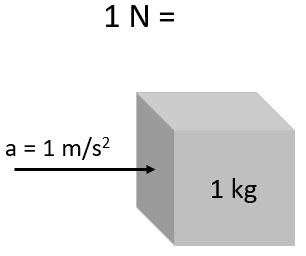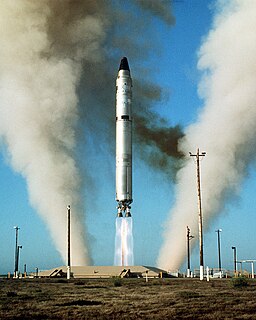
An intercontinental ballistic missile (ICBM) is a guided ballistic missile with a minimum range of 5,500 kilometres (3,400 mi) primarily designed for nuclear weapons delivery. Similarly, conventional, chemical, and biological weapons can also be delivered with varying effectiveness, but have never been deployed on ICBMs. Most modern designs support multiple independently targetable reentry vehicles (MIRVs), allowing a single missile to carry several warheads, each of which can strike a different target.

The LGM-30 Minuteman is a U.S. land-based intercontinental ballistic missile (ICBM), in service with the Air Force Global Strike Command. As of 2018, the LGM-30G Minuteman III version is the only land-based ICBM in service in the United States.

The SM-65 Atlas was the first operational intercontinental ballistic missile (ICBM) developed by the United States and the first member of the Atlas rocket family. It was built for the U.S. Air Force by Convair Division of General Dynamics at the Kearny Mesa assembly plant north of San Diego. Atlas became operational as an ICBM in October 1959 and was used as a first stage for satellite launch vehicles for half a century. The Atlas missile's warhead was over 100 times more powerful than the bomb dropped over Nagasaki in 1945.

Vandenberg Air Force Base is a United States Air Force Base 9.2 miles (14.8 km) northwest of Lompoc, California. It is under the jurisdiction of the 30th Space Wing, Air Force Space Command (AFSPC).
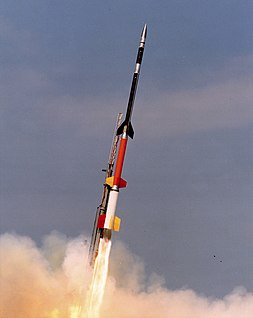
The Black Brant is a family of Canadian-designed sounding rockets originally built by Bristol Aerospace, since absorbed by Magellan Aerospace in Winnipeg, Manitoba. Over 800 Black Brants of various versions have been launched since they were first produced in 1961, and the type remains one of the most popular sounding rockets ever built. They have been repeatedly used by the Canadian Space Agency and NASA.

The Saturn IB was an American launch vehicle commissioned by the National Aeronautics and Space Administration (NASA) for the Apollo program. It replaced the S-IV second stage of the Saturn I with the much more powerful S-IVB, able to launch a partially fueled Apollo command and service module (CSM) or a fully fueled lunar module (LM) into low Earth orbit for early flight tests before the larger Saturn V needed for lunar flight was ready.

The Pegasus is an air-launched rocket developed by Orbital Sciences Corporation. Capable of carrying small payloads of up to 443 kilograms (977 lb) into low Earth orbit, Pegasus first flew in 1990 and remains active as of 2018. The vehicle consists of three solid propellant stages and an optional monopropellant fourth stage. Pegasus is released from its carrier aircraft at approximately 40,000 ft (12,000 m), and its first stage has a wing and a tail to provide lift and attitude control while in the atmosphere.

A launch vehicle or carrier rocket is a rocket used to carry a payload from Earth's surface through outer space, either to another surface point, or into space. A launch system includes the launch vehicle, launch pad, vehicle assembly and fuelling systems, range safety, and other related infrastructure.

The Scout family of rockets were American launch vehicles designed to place small satellites into orbit around the Earth. The Scout multistage rocket was the first orbital launch vehicle to be entirely composed of solid fuel stages.
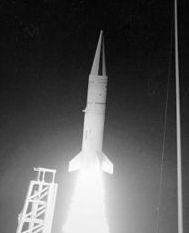
Aries is an American sounding rocket and target rocket, developed by Space Vector Corporation from retired LGM-30 Minuteman I intercontinental ballistic missile (ICBM) stages for use by the United States Air Force and NASA. Taken over by Orbital Sciences Corporation, Aries, as the Target Test Vehicle, remains in use.
The Nike-Cajun was a two-stage sounding rocket built by combining a Nike base stage with a Cajun upper stage. It was launched 714 times between 1956 and 1976 and was the most frequently used sounding rocket of the western world. The Nike Cajun had a launch weight of 698 kg (1538 lb), a payload of 23 kg (51 lb), a launch thrust of 246 kN (55,300 lbf) and a maximum altitude of 120 km (394,000 ft). It had a diameter of 42 cm and a length of 7.70 m. The maximum speed of the Nike-Cajun was 6,760 km/h (4,200 mph).

The RT-2 was an intercontinental ballistic missile deployed by the Soviet Union, which was in service from December 1968 until 1976. It was assigned the NATO reporting name SS-13 Savage and carried the GRAU index 8K98. Designed by OKB-1, about 60 were built by 1972.
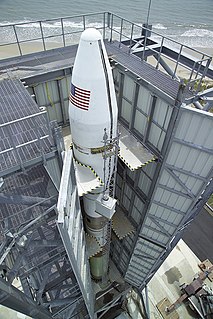
The Minotaur is a family of American solid fuel rockets derived from converted Minuteman and Peacekeeper intercontinental ballistic missiles. They are built by Northrop Grumman via contract with the Air Force Space and Missile Systems Center's Space Development and Test Directorate (SMC/SD) as part of the Air Force's Rocket Systems Launch Program which converts retired Intercontinental Ballistic Missiles (ICBMs) into space and test launch systems for US Government Agencies.
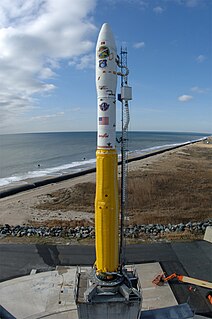
The Minotaur I, or just Minotaur is an American expendable launch system derived from the Minuteman II missile. It is used to launch small satellites for the US Government, and is a member of the Minotaur family of rockets produced by Orbital Sciences Corporation.

The Castor family of solid-fuel rocket stages and boosters built by Thiokol and used on a variety of launch vehicles. They were initially developed as the second-stage motor of the Scout rocket. The design was based on the MGM-29 Sergeant, a surface-to-surface missile developed for the United States Army at the Jet Propulsion Laboratory.

Minotaur II rockets consist of the M55A1 first stage and SR19AJ1 second stage of a decommissioned Minuteman missile. The third stage varies depending on the configuration required for the payload. A Minuteman II M57A1 stage is used on the baseline configuration, whilst the Minotaur II+ uses an SR-73-AJ. The Minotaur II Lite is a two-stage configuration, without a third stage. A heavy configuration is also available, with an Orion 50XL third stage, as used on the Minotaur I. The baseline configuration can propel a 400 kilograms (880 lb) payload into a 4,000 kilometres (2,500 mi) downrange, whilst the heavy configuration can place 1,400 kilograms (3,100 lb) onto a 8,000-kilometre (5,000 mi) trajectory.

The Emergency Rocket Communications System (ERCS) was designed to provide a reliable and survivable emergency communications method for the United States National Command Authority, using a UHF repeater placed atop a Blue Scout rocket or Minuteman II intercontinental ballistic missile. ERCS was deactivated as a communication means when President George H.W. Bush issued a message to stand down SIOP-committed bombers and Minuteman IIs on 27 September 1991. Headquarters SAC was given approval by the Joint Chiefs of Staff to deactivate the 494L payloads beginning 1 October 1992. However, Headquarters SAC believed it was inefficient and unnecessary to support ERCS past fiscal year 1991, and kept the accelerated deactivation schedule.
The Blok DM-03, GRAU index 11S861-03, is a Russian upper stage used as an optional fourth stage on the Proton-M carrier rocket. Three have been launched, the first in December 2010; the first two launches failed before fourth stage ignition, the first as a result of a problem with the Blok DM's fuel load.
The Algol family of solid-fuel rocket stages and boosters built by Aerojet and used on a variety of launch vehicles. It was developed by Aerojet from the earlier Jupiter Senior and the Navy Polaris programs. Upgrades to the Algol motor occurred from 1960 till the retirement of the Scout launch vehicle in 1994.



